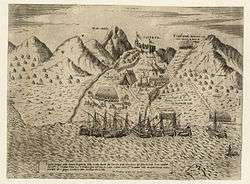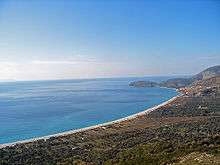Borsh
| Borsh | |
|---|---|
| Village | |
|
Borsh Castle | |
 Borsh | |
| Coordinates: 40°3′45″N 19°51′24″E / 40.06250°N 19.85667°ECoordinates: 40°3′45″N 19°51′24″E / 40.06250°N 19.85667°E | |
| Country |
|
| County | Vlorë |
| Municipality | Himarë |
| Administrative Unit | Lukovë |
| Elevation | 0 m (0 ft) |
| Time zone | CET (UTC+1) |
| • Summer (DST) | CEST (UTC+2) |
Borsh is a maritime village, in the Albanian Riviera, in the former Lukovë municipality, Vlorë County, Albania,[1] At the 2015 local government reform it became part of the municipality Himarë.[2] The village is inhabited by Muslim Albanians.[3]
Borsh borders with Fterra, Qeparo, Piqerras and has a population of 2500 inhabitants.
Borshi's History

The region which Borshi is located was part of the Chaonia of the ancient region of Epirus. The castle remained in use in Roman times and was refortified by the Emperor Justinian in the sixth century. Nothing is known of the settlement in the Byzantine era, until it is mentioned as Sopotos in 1258 when it was part of the Despotate of Epirus tha grew out of the failing Byzantine empire. Borsh then went through a period of considerable turmoil, changing hands several times between the Despotate of Epirus and Norman crusades invaders before being taken by the Turks in 1431.
Fifty years later it was captured by Albanians led by Skenderbeg, but was retaken by the Turks only eleven years later and heavily refortified. On June 10, 1570 the castle of Sopot was taken by James Celsi, Proveditor of the Venetian navy, who left after leaving in charge the Greek commander of Nauplion, Emmanuel Mormoris. This also triggered part of the nearby Himariotes to submit to Venetian rule.[4] The next year the Ottoman army recaptured it and took Mormori as a prisoner.
.jpg)
The fortress was renovated again by Ali Pasha Tepelena, and it is these fortifications that visitors can view by taking the half-hour walk up to the ‘castle rock’ the limestone mount clearly visible above the old village. During Ali pasha’s reign there were 700 houses at Borsh, and below the castle mount you can see a ruined mosque and madrese (a Muslim theological school), both of which were damaged in Ali Pasha’s wars but survived, only to be destroyed by fighting after 1912 when the Turks left the region.
Between 1912 and 1914 serious inter-ethnic conflict took place between Greeks and Albanians, and significant portion of the old village was destroyed, however some fine buildings remain. Modern Borsh was built after that, but became seriously depopulated, first due to malaria, and following severe reprisal killings by Germans in WW2 however, depopulation was balanced by an influx of refugees from Vlora, fleeing into partisan territory from the city which was heavily contested until late in the war.
Tourism


The village is very stable and growing in prosperity thanks to tourism and olive oil production. The thing that makes Borsh very popular is its beach, which is the largest beach in Ionian sea (7 km).
The tourism has begun to develop a lot thanks to village's beauty and thanks to its friendly people. Continuing in this way Borsh will become soon the best destination for tourists in the South of Albania.
See also
References
| Wikimedia Commons has media related to Borsh. |
- ↑ "Location of Borsh". Retrieved 2010-06-20.
- ↑ Law nr. 115/2014
- ↑ Kallivretakis, Leonidas (1995). "Η ελληνική κοινότητα της Αλβανίας υπό το πρίσμα της ιστορικής γεωγραφίας και δημογραφίας [The Greek Community of Albania in terms of historical geography and demography." In Nikolakopoulos, Ilias, Kouloubis Theodoros A. & Thanos M. Veremis (eds). Ο Ελληνισμός της Αλβανίας [The Greeks of Albania]. University of Athens. p. 51. " AM Αλβανοί Μουσουλμάνοι”; p.53. “BORSH ΜΠΟΡΣΙ 1243 AM"
- ↑ Hill, George (2010). A History of Cyprus. Cambridge University Press. p. 911. ISBN 978-1-108-02064-0.
